Meat chickens can be very different than egg layers. Are you looking to raise chickens for their delicious meat? We’ve got you covered! This comprehensive guide explores the top 10 best chickens for meat in 2023. From fast-growing broiler breeds to versatile dual-purpose and traditional heritage breeds, there’s a perfect choice for everyone. So let’s dive into this exciting poultry world and discover the breed that best suits your taste buds and needs!

Short Summary
- Choose the right meat chicken breed for your needs & preferences
- Experience taste preferences & potential of dual-purpose breeds like Rhode Island Red and Buff Orpington
- Discover the delicious traditional flavor of Heritage Breeds with Bresse and Jersey Giant, an exciting adventure for any chicken lover
- Raising your meat chicken breeds lets you know they were ethically and humanely treated during their growth period
Choosing the Right Meat Chicken Breed
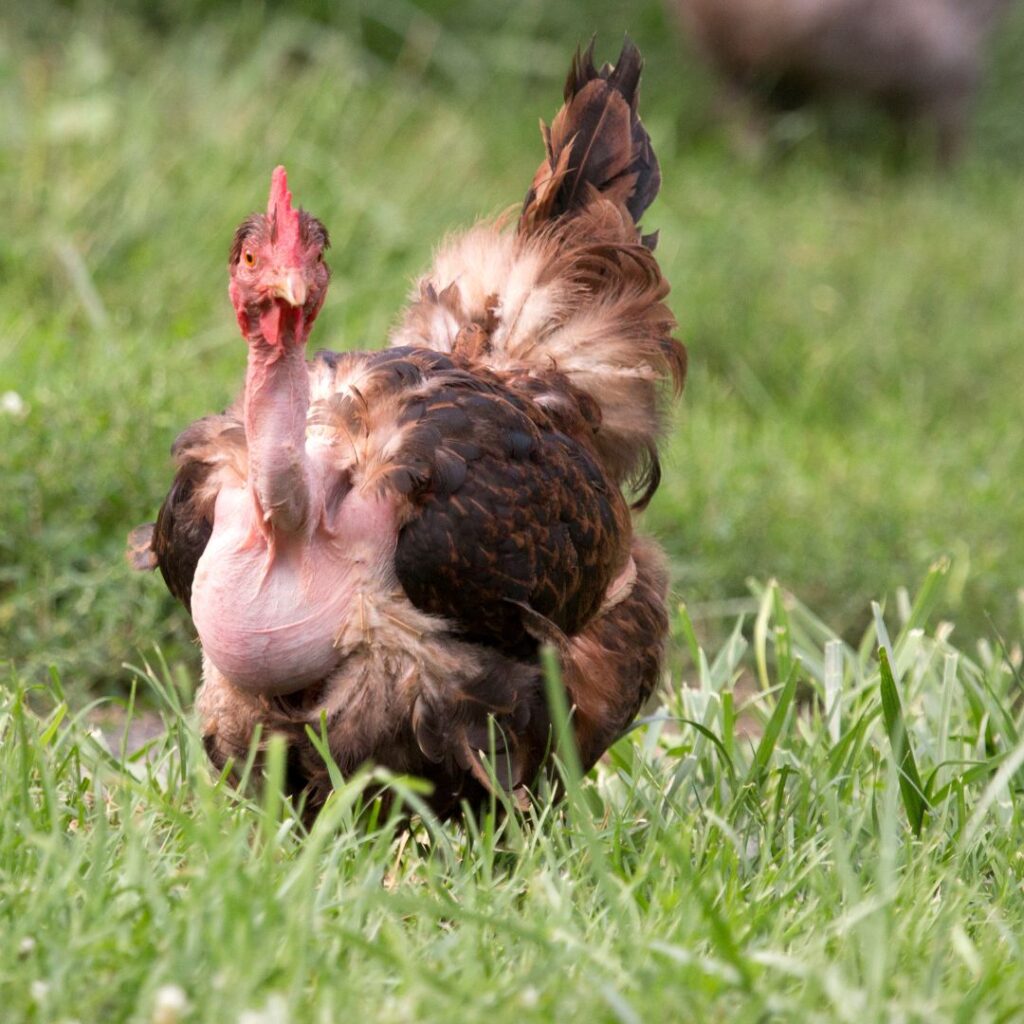
Selecting the perfect meat chicken breed can be daunting, especially with the myriad options available. But fear not! We’re here to help you decide based on essential factors such as growth rate, size, taste preferences, and egg production potential. Considering these factors, you can narrow your options and choose the best meat chicken breeds for your specific requirements and preferences.
So let’s explore these factors in more detail and get you one step closer to raising your delicious, tender meat chickens!
Growth Rate and Size
The growth rate and size of meat chickens are crucial in determining the amount of meat they’ll provide. Larger chickens, such as the Cornish Cross, are known for their rapid growth rate and impressive size, making them popular among commercial meat producers.
However, their lightning-fast growth rate is controversial, as it can result in health issues like heart attacks or legs breaking from their rapid growth and size. So, weighing the pros and cons of each breed’s growth rate and size is essential before deciding.
If you’re concerned about the health issues associated with fast-growing meat chickens, don’t worry; other options are available. For instance, Delaware chickens grow slower, reaching a mature weight of 7-9 lbs within 18-20 weeks.
You can ensure a healthier and happier flock by selecting a breed with a growth rate and size that aligns with your preferences and values.
Taste Preferences
When it comes to taste preferences, choosing a chicken breed that suits your taste buds is essential. The flavor of chicken meat can vary wildly from breed to breed, with factors such as diet and breed making a difference in the taste.
Some people believe that Red Rangers are the best-tasting meat chickens and have a sweeter taste to their meat than Cornish Cross. This demonstrates how different breeds can affect the flavor profile of poultry. Another option is the Freedom Rangers, known for their unique roasted flavor.
By taking the time to research and taste-test different breeds, you can find the perfect meat chicken breed that will leave your taste buds dancing.
Egg Production Potential
If you’re interested in a chicken breed that can produce eggs, dual-purpose breeds are the way to go. These versatile breeds, such as Rhode Island Red and Buff Orpington, offer the best of both worlds, providing a steady supply of eggs and meat. They are also known for their adaptability and hardiness, making them an excellent choice for novice and experienced chicken keepers.
Some dual-purpose breeds, such as the Naked Neck aka theTurken, go above and beyond in egg production, laying around 200 -220 eggs annually.
By choosing a dual-purpose breed, you can enjoy the benefits of raising chickens for meat and eggs, offering versatility and sustainability in your chicken flock.
Broiler Breeds: Fast-Growing Meat Chickens

For those who prioritize quick meat production and don’t mind the potential health issues of rapid growth, broiler-breed chickens are an excellent choice, even in cold climates.
These fast-growing meat birds, such as the Cornish Crosses and Freedom Rangers, are specifically bred for meat production and grow at an impressive pace.
This section explores two popular broiler breeds and their unique characteristics.
Cornish Cross
The Cornish Cross is a popular broiler breed known for its fast growth rate and large size. These chickens can reach a mature weight of 9-12 lbs in 8-12 weeks.
However, their rapid growth rate can result in health issues such as leg problems, overeating, and heart and respiratory problems. Despite these potential drawbacks, Cornish Cross chickens are still a top choice among commercial meat producers due to their large amount of white meat and dark meat and rapid growth.
If you’re considering raising Cornish Cross chickens, you must be aware of their potential health issues and provide the proper care and attention to ensure their well-being.
Raising them on pasture with a suitable enclosure can help mitigate some health risks and result in healthier, happier chickens.
Freedom Rangers
As an alternative to the Cornish Cross, Freedom Rangers offer a slightly slower growth rate but better foraging abilities. These hardy chickens are known for their adaptability to pasture-raising and their excellent foraging skills, which can save on food costs. They also lay eggs and produce delicious meat.
Freedom Rangers are an excellent choice for those who value a more natural growth rate and better foraging abilities in their meat chickens. By choosing a breed like the Freedom Rangers, you can enjoy the benefits of raising meat chickens without the potential health issues of rapid growth.
Dual-Purpose Breeds: Meat and Eggs
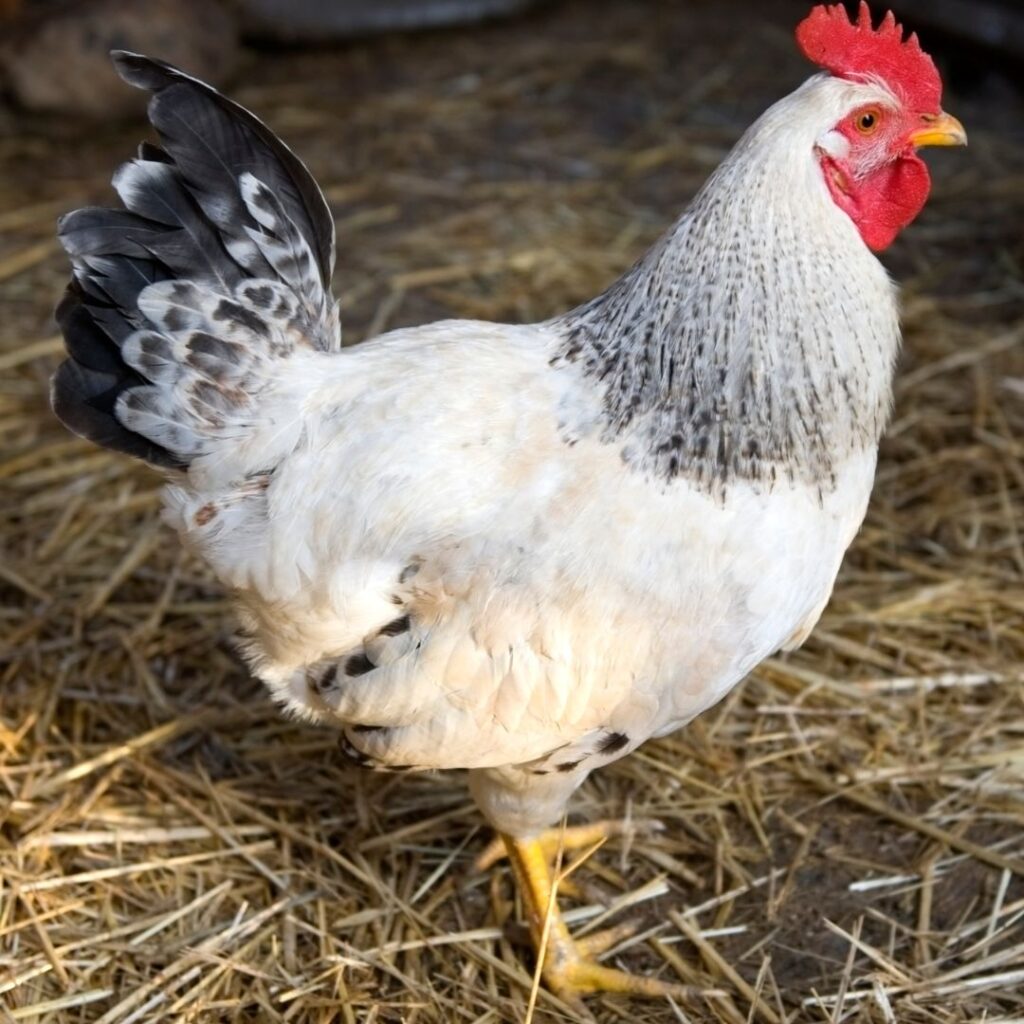
If you want versatility in your chicken flock, dual-purpose breeds are the perfect choice. These breeds are suitable for meat and egg production, offering homesteaders a sustainable and efficient option.
This section introduces you to two popular dual-purpose breeds, the Rhode Island Red and Buff Orpington, and discusses their unique characteristics and benefits. These are the best meat chickens for homesteading, also providing sustainable flocks with their broody hens.
Rhode Island Red
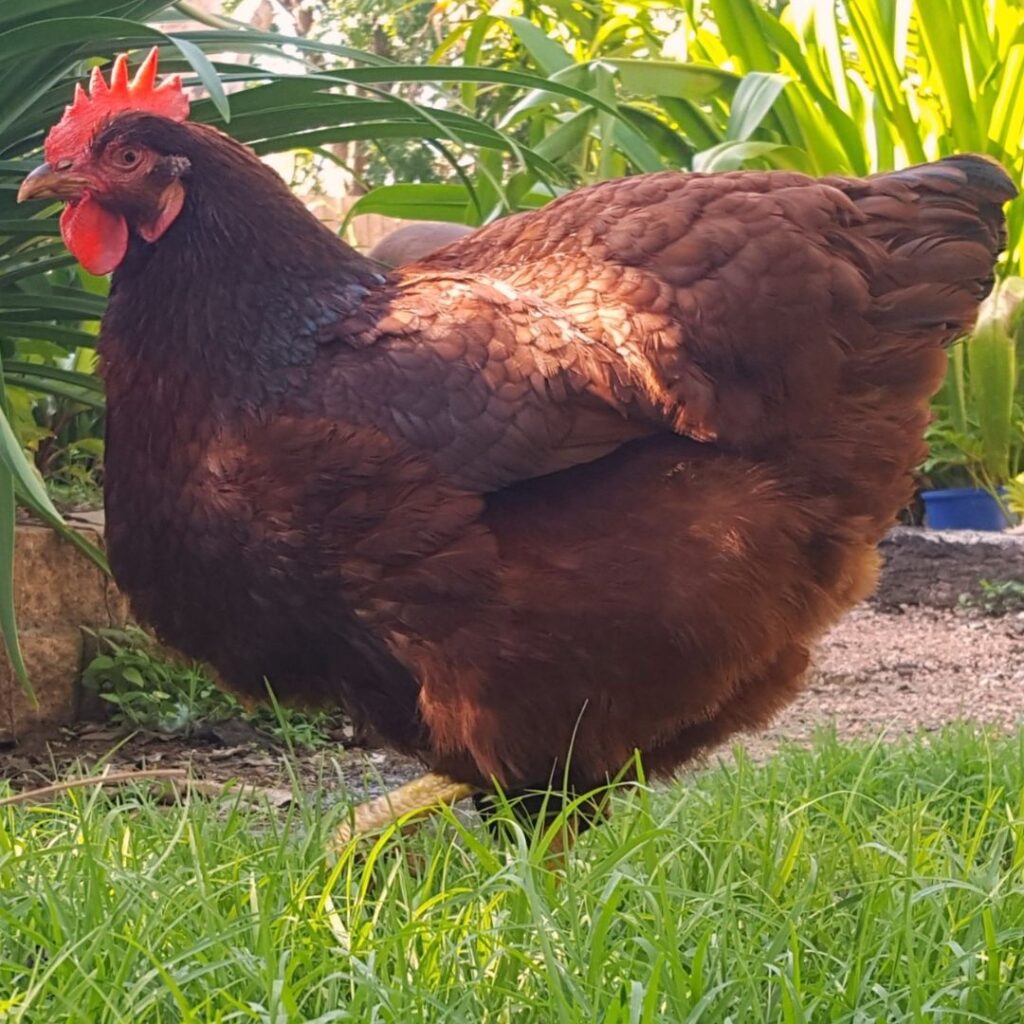
The Rhode Island Red is a hardy and adaptable breed for meat and egg production. These chickens are known for their excellent foraging abilities and alertness to predators, making them a smart choice for those raising chickens in a free-range environment.
They also lay a decent amount of eggs, ensuring a steady supply of eggs and meat for many years.
Rhode Island Reds are an excellent choice for a reliable dual-purpose breed. Their hardiness, adaptability, and impressive egg-laying abilities make them popular among chicken keepers.
Their meat is known for being tender and delicious, making them a great addition to any homestead.
Buff Orpington
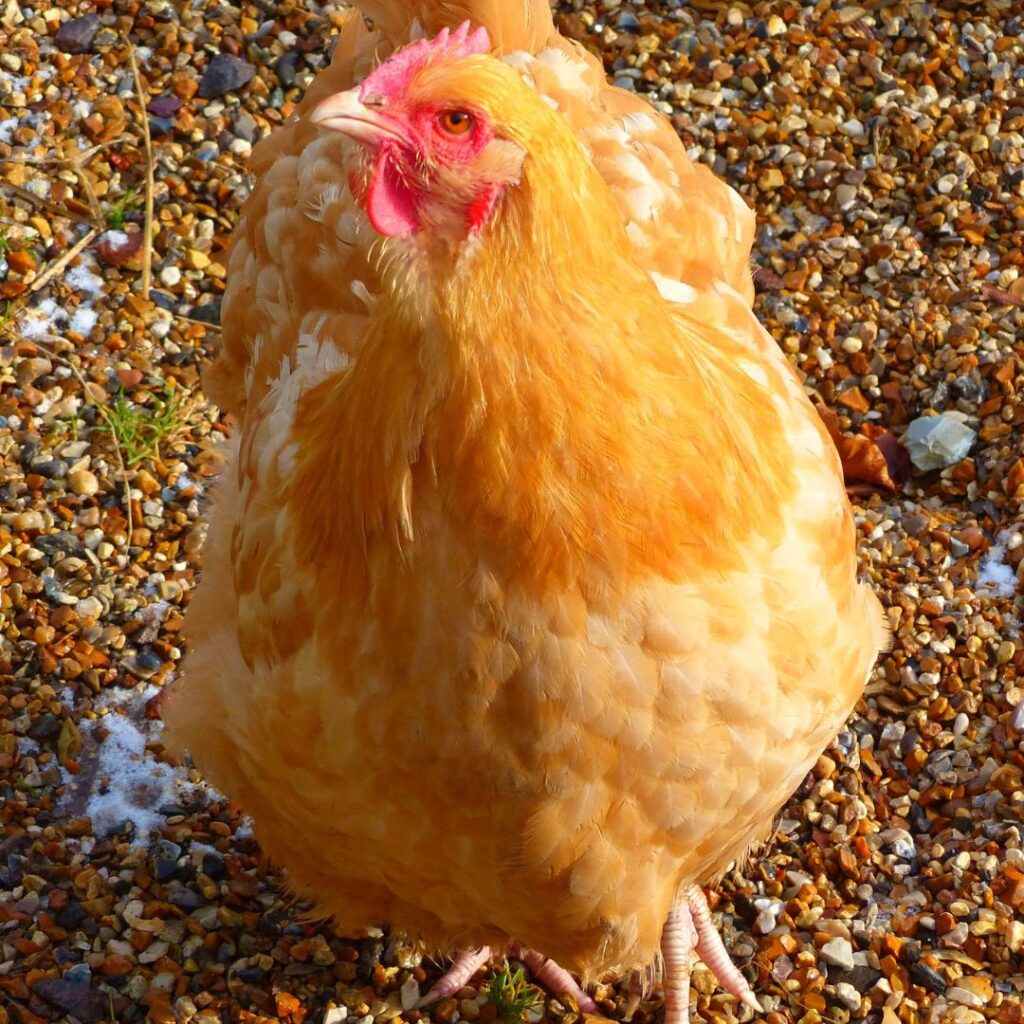
Buff Orpington is another fantastic dual-purpose chicken good for meat and egg production. These large, docile chickens are known for their fluffy feathers and gentle temperament, making them an ideal choice for families with kids. They can also thrive in various climates, ensuring a healthy and happy flock regardless of your location.
In addition to their meat production capabilities, Buff Orpingtons are also known for their egg-laying abilities.
Their versatility and adaptability make them popular for homesteaders seeking a reliable dual-purpose breed. You can enjoy the benefits of raising chickens for meat and eggs in a single, versatile breed by choosing a breed like the Buff Orpington.
Heritage Breeds: Traditional and Flavorful
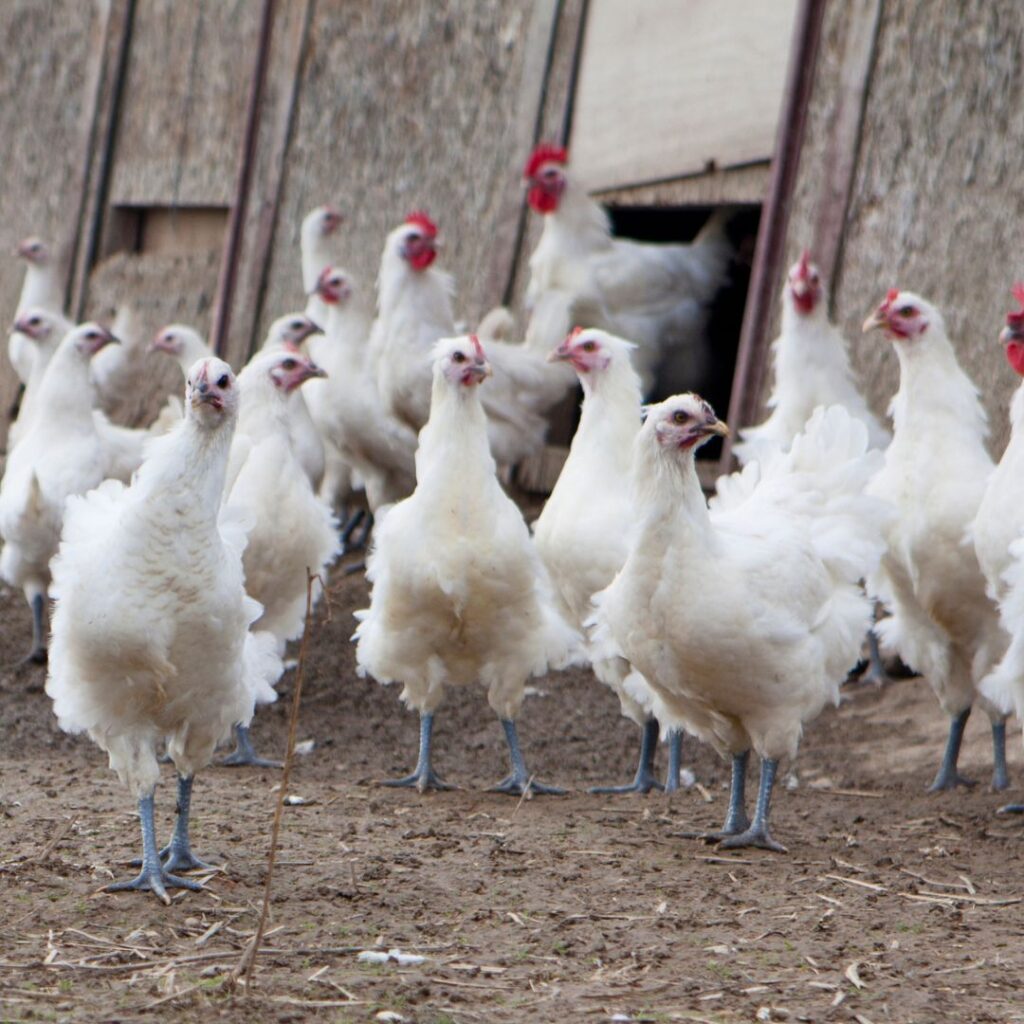
For those who appreciate traditional chicken breeds and the unique flavors they offer, heritage breeds are an excellent choice.
These breeds are known for their slow growth rate, longer life spans, and flavorful meat, making them a popular choice among those looking for a more traditional approach to raising chickens for meat.
This section explores two heritage breeds, the Bresse and Jersey Giant, and discusses their unique characteristics and taste profiles.
Bresse
Bresse chickens are renowned for their delicious meat and are ideal for those seeking top-quality meat production. Originating from France, these chickens are known for their adaptability to pasture-raising and excellent foraging abilities.
Their unique taste and texture are highly sought, making them a prized breed among culinary enthusiasts.
Bresse chickens are an excellent choice if you want to raise them for their exquisite flavor. Their delicious meat, adaptability to pasture-raising, and foraging skills make them a valuable addition to any homestead or small farm.
By choosing this heritage breed, you’ll raise chickens with a long history of exceptional taste and quality.
Jersey Giant
The Jersey Giant is another heritage breed known for its impressive size and delicious meat. These slow-growing chickens can reach a mature weight of 10-13, sometimes even 15 lbs, making them one of the largest chicken breeds in the world.
Their gentle nature also makes them an excellent choice for families with kids.
Jersey Giants are an excellent choice for those seeking a large, slow-growing breed suitable for meat and egg production.
Their size and gentle temperament make them a popular choice among chicken enthusiasts. By choosing a breed like the Jersey Giant, you’ll raise a traditional and flavorful breed that will impress at the dinner table.
Raising Meat Chickens: Tips and Considerations
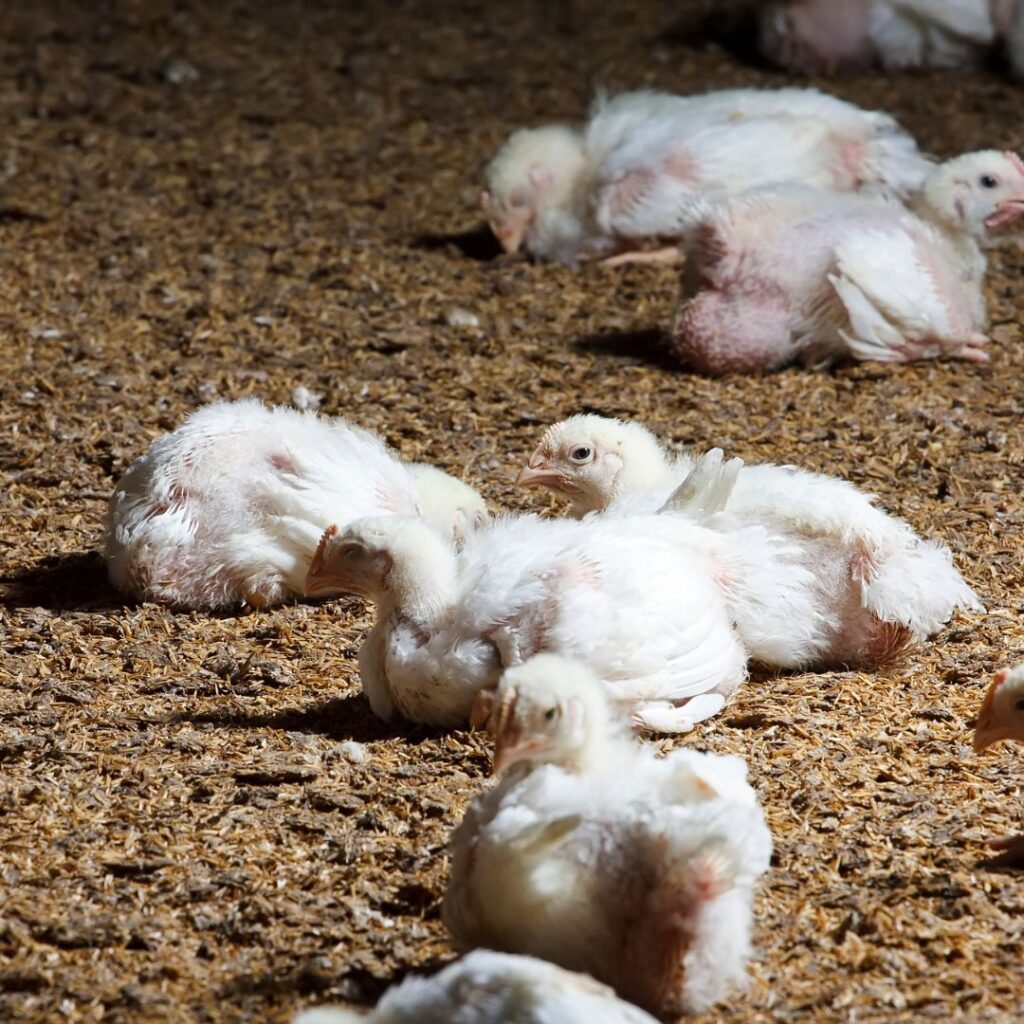
Now that you’ve learned about the various meat chicken breeds and their unique characteristics, it’s time to explore the tips and considerations for raising them. This section provides helpful advice on housing and space requirements, feeding and nutrition, and processing and butchering techniques.
By following these guidelines, you’ll be well on your way to raising healthy and delicious meat chickens for your family.
Housing and Space Requirements
Ensuring proper housing and space requirements for your meat chickens is essential to promoting healthy growth and development.
Meat chickens need at least 2 square feet of space per bird in a clean, dry, and draft-free habitat. A reliable heat source, such as a heat lamp, is also necessary.
Adjusting the feeder and water as the birds grow is essential to ensure they can access the necessary nutrients.
By providing appropriate housing and space, you can create a comfortable and healthy environment for your meat chickens to thrive.
Feeding and Nutrition
Proper feeding and nutrition are vital for your meat chickens to reach their full potential for meat production.
Meat chickens require a balanced diet that contains at least 38 nutrients in appropriate concentrations and balance. During the first four weeks, they need a starter feed that contains 20 to 23 percent protein, depending on the energy content of the feed.
After that, they need a grower feed for 29-49 days of age and a finisher feed with a protein content between 16% and 18% for the next 5+ weeks.
In addition to providing a balanced diet, it’s crucial to provide fresh, clean water at all times and monitor the chickens for signs of malnutrition.
Chickens can benefit a great deal when allowed to free range. This gives them exercise, Vitamin D, excellent protein sources, and other valuable nutrients. Let your chickens help you with weeds, grass clippings, and even ticks in your yard. You’ll all reap the benefits.
By following these feeding and nutrition guidelines, you can ensure your meat chickens grow healthy and strong.
Processing and Butchering

Once your meat chickens have reached the appropriate age and weight, it’s time to learn about processing and butchering techniques to safely and efficiently harvest your meat chickens.
In the United States, the age at which meat chickens are butchered is generally between 6-12 weeks, depending on the breed and desired weight.
To butcher chickens, you will need to prepare some tools and equipment, such as bleach, easily cleanable surfaces, a culling cone, plastic or stainless steel buckets, a stockpot large enough to dunk a whole chicken, sharp knives, cooler with ice, and food sealer or freezer bags.
Proper processing and butchering techniques can ensure a safe and efficient harvest of your meat chickens.
Important Note: Refer to state law about butchering and selling chicken – some states require that a chicken is processed in a certified facility.
Conclusion
Choosing the best chicken as a meat breed depends on your needs and preferences, such as growth rate, size, taste, and egg production potential.
Whether you opt for a fast-growing broiler breed like the Cornish Cross or Freedom Ranger, a versatile dual-purpose breed like the Rhode Island Red or Buff Orpington, or a traditional and flavorful heritage breed like the Bresse or Jersey Giant, you’ll be raising delicious and tender table meat for your family.
We hope this guide has provided valuable information on the top 10 best chickens for meat in 2023 and tips and considerations for raising them.
Be sure to read all our beginner chicken owner tips.
With the right breed, proper housing and nutrition, and efficient processing techniques, you’ll be well on your way to enjoying homegrown chicken meat that is both delicious and nutritious.
Here’s to your success in raising your meat birds.
Frequently Asked Questions
What chickens grow fast for meat?
If you’re looking for chickens that grow fast for meat, look no further than the Cornish Cross. These birds are specifically bred to reach up to 12 lbs in 8 weeks – an impressive feat of growth! Homesteaders and commercial producers alike love this breed for their reliable growth rates.
Get ready for juicy, succulent chicken dinners in record time!
What are the best egg and meat chickens, aka dual-purpose chickens?
Rhode Island Reds are the ideal choice if you’re looking for a chicken breed that gives you amazing eggs and meat! These chickens are known for their ability to produce a high quantity of large, brown eggs while still providing quality, tender meat.
They’re the perfect option for any homesteader looking for a dual-purpose breed.
Which chickens are killed for meat?
So, these broiler chickens are ultimately killed and processed to provide meat for consumption. All this work ensures that the animals are handled properly and given a humane end.
What factors should I consider when choosing a meat chicken breed?
Choosing the proper chicken for meat requires careful consideration of factors such as growth rate, size, taste, and egg production potential – all of which can help you make the perfect choice for your backyard flock.
When selecting a breed, it is essential to consider its growth rate, size, taste, and egg production potential. This will help you determine which breed best suits your backyard flock. It would be best if you also consider your climate. Some breeds, such as the Rhode Island Reds, are extremely cold hardy breeds. Another breed could be less tolerant and suffer through a harsh winter.
are bresse chickens broody?
Bresse hens are less broody than some hens, however make great moms. Consider incubating or placing your fertilized eggs under a more broody hen to hatch a sustainable flock.
Are there any health concerns with fast-growing meat birds like the Cornish Cross?
Yes, there are health concerns associated with fast-growing chickens like the Cornish Cross, such as leg issues due to rapid growth and cardiac and respiratory problems.
Take care when raising these chickens to prevent possible problems.

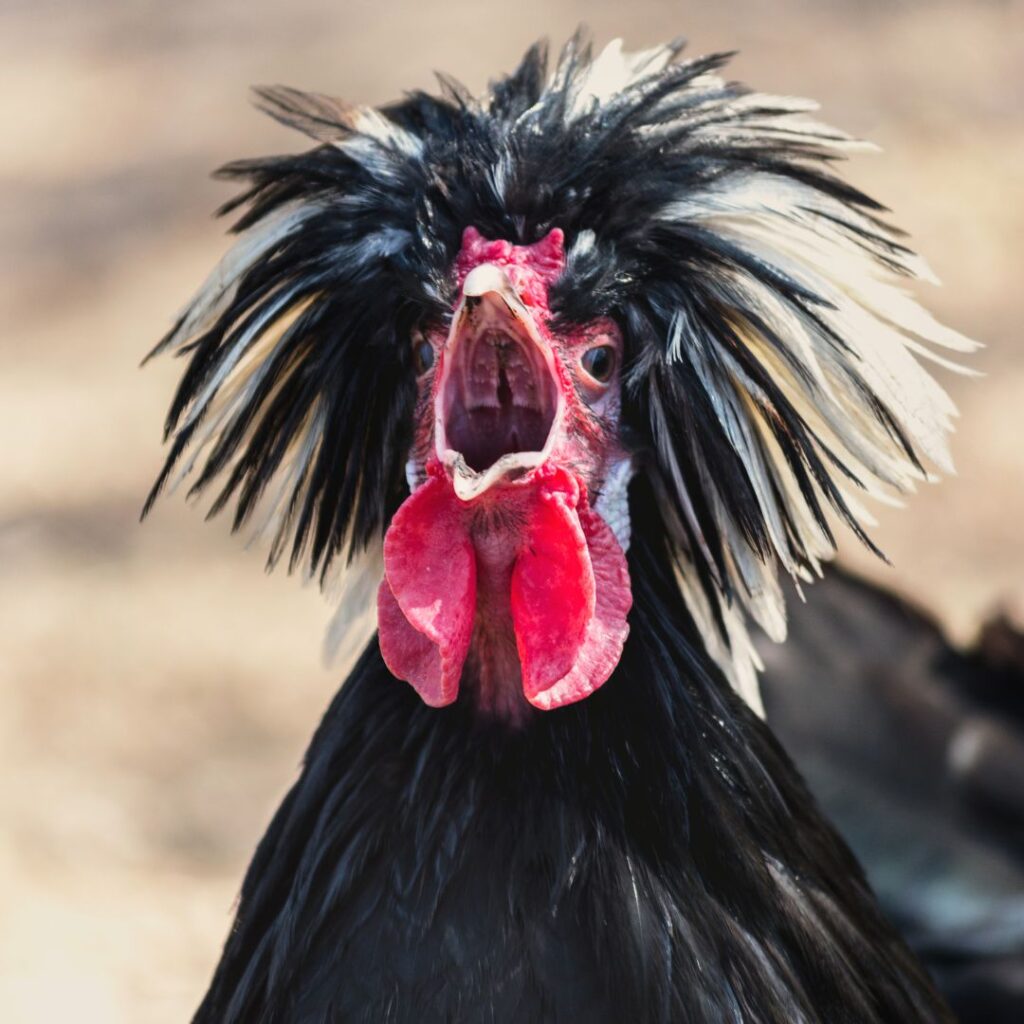
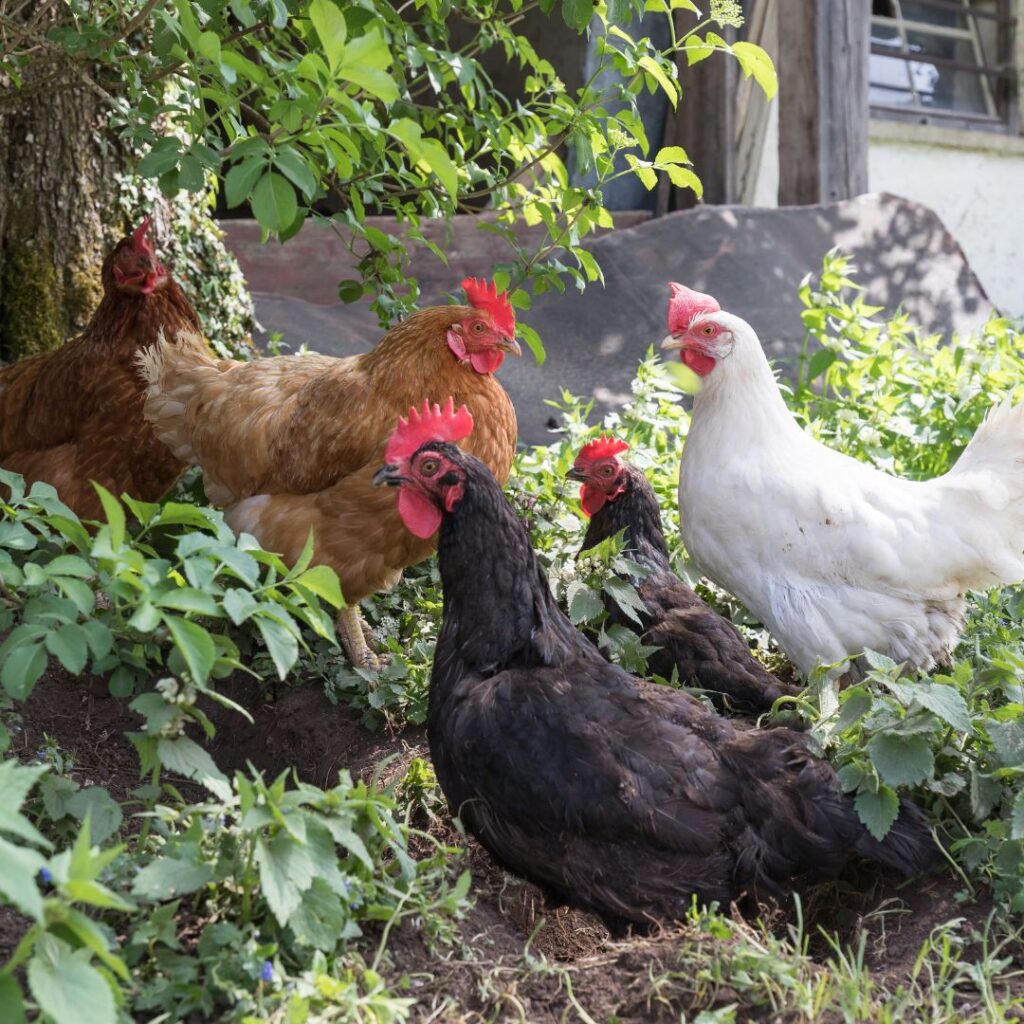
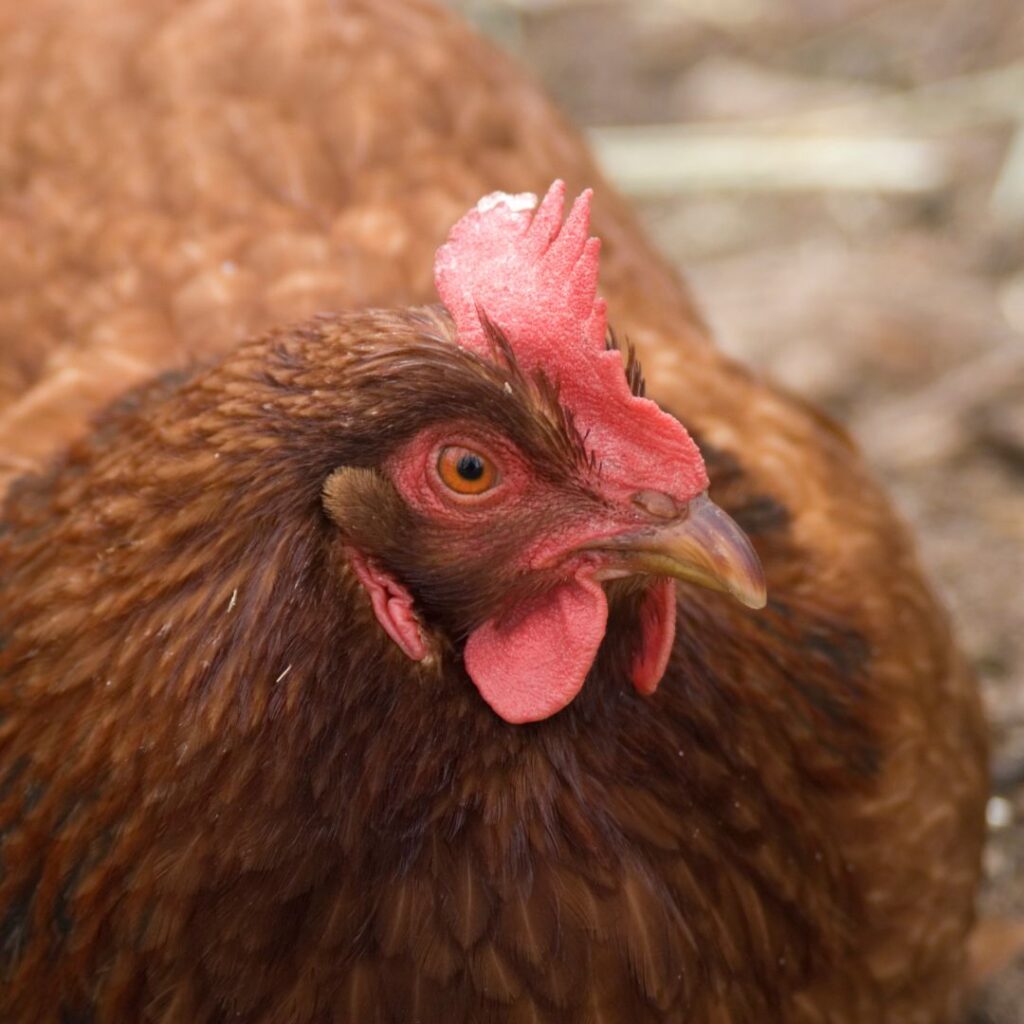
Pingback: Find The Best Chicken Breeders In 2023 | Buy Chicks Online